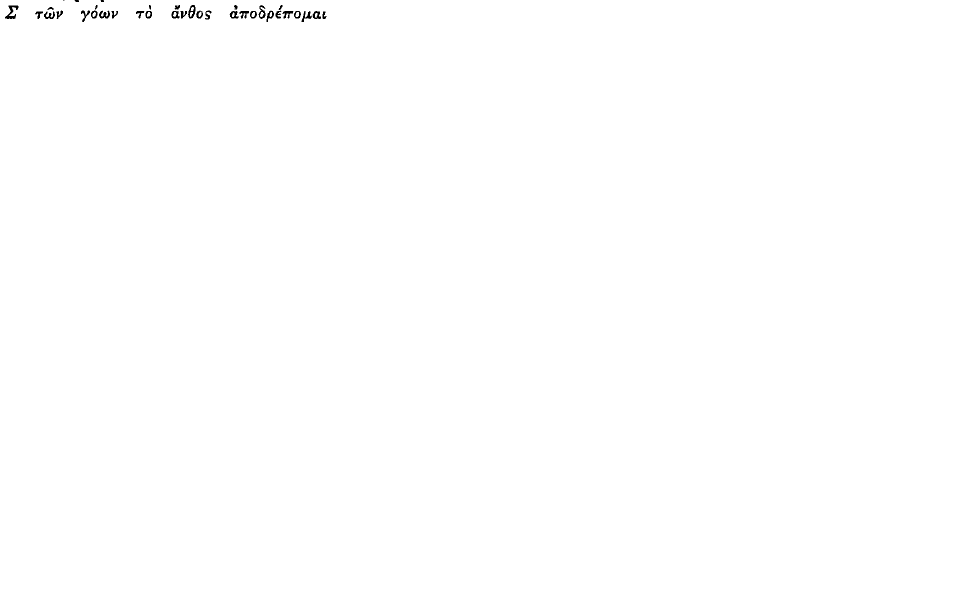Article contents
Two Notes on Aeschylus, Supplices
Published online by Cambridge University Press: 11 February 2009
Extract
‘And now invoking as our helper overseas Zeus' calf and the son of the flower-browsing ancestress cow by conception from the on-breathing of Zeus—’: so begins the appeal of Danaos' daughters to their forefather Epaphos; the opening sentence is interrupted by a digression and never completed. In 43 M reads  (Porson) is almost universally adopted. However,
(Porson) is almost universally adopted. However,  (Tucker) is printed in the current Oxford text (1955). Porson's emendation was attacked by Tucker on various grounds: (1) it was palaeographically unsatisfactory, (2) it added an otiose epithet to
(Tucker) is printed in the current Oxford text (1955). Porson's emendation was attacked by Tucker on various grounds: (1) it was palaeographically unsatisfactory, (2) it added an otiose epithet to  but left
but left  unqualified, (3) it involved a ‘scarcely Greek’ use of the participle, and (4) it coined a form in
unqualified, (3) it involved a ‘scarcely Greek’ use of the participle, and (4) it coined a form in  having the unique sense ‘graze’ instead of ‘handle’. My purpose is to defend
having the unique sense ‘graze’ instead of ‘handle’. My purpose is to defend  as the true reading and to explore its contextual significance. I begin by taking Tucker's objections in order.
as the true reading and to explore its contextual significance. I begin by taking Tucker's objections in order.
- Type
- Research Article
- Information
- Copyright
- Copyright © The Classical Association 1964
References
page 24 note 1 Correctly recorded by Wecklein and Sidgwick: two words are indicated by the gap and absence of ligature.
page 24 note 2 e.g. by Headlam (in his translation), Wecklein, Wilamowitz, Mazon, Weir Smyth, Vurtheim.
page 24 note 3 Also in Murray's earlier edition (1938) and that of Sidgwick (1902).
page 24 note 4 Cf, e.g.,  in A at Il. 1. 113.
in A at Il. 1. 113.
page 24 note 5 N.B. A. Ag. 1305  Auratus:
Auratus:  F Tri., S.O.C. 1121
F Tri., S.O.C. 1121  Musgrave:
Musgrave:  codd.
codd.
page 24 note 6 Cf. refs. at p. 26 n. 3also Murray, R. D., The Motif of Io in Aeschylus' Suppliants. (1958), pp. 23 ff.Google Scholar
page 25 note 1 See further Alexander, W. J., A.J.P. iv (1882), 293–300,Google Scholar Pearson on S. Fr. 858. 3, Schwyzer, E., Griechische Grammatik, ii. 407–8.Google Scholar
page 25 note 2 See, e.g., Humbert, J., Syntaxe grecque (ed. 3, 1960), p. 128.Google Scholar
page 25 note 3 Further exx. ap. Schwyzer, Griechische Grammatik, ii. 408.Google Scholar
page 25 note 4 Cf. Stanford, W. B., Aeschylus in his Style (1942), pp. 63–64.Google Scholar
page 25 note 5 Schuursma, J. A., De Poetica Vocabulorum Abusione apud Aeschylum (1932), p. 157. Schuursma does not discuss  .Google Scholar
.Google Scholar
page 25 note 6 Cf. exx. ap. Thomson, G., The Oresteia of Aeschylus (1938), i. 79.Google Scholar
page 25 note 7 his has predominantly anthropomorphic associations: see Tucker's note, also Fraenkel on Ag. 717.
page 25 note 8 Cf., too, 170 

page 25 note 9 Paley interprets the sense as ‘invoking Epaphus, not only as a patron-god able to protect us on the other side of the water, but also as the son of our ancestress’, an anti thesis which allows of simpler word-order but is entirely lacking in point.
page 25 note 10 Cf. Od. 18. 372, Theoc. 25. 132, Q.S. 1. 397, etc. There is little distinction of meaning between h. Ven. 78 
 and 169
and 169  but there the act of browsing is not emphasized.
but there the act of browsing is not emphasized.
page 26 note 1 It is suggestive that Nemea, where Io grazed (Luc. D. Deor. 3) was said by some to be named from the browsing of Hera's sacred cattle (refs. in. R.-E. xxxii. 2313, s.v.;Google Scholar cf. Cook, A. B., Zeus, i [1914], p. 446).Google Scholar
page 26 note 2 Cf. Hdt. 2. 38, 2. 153, 3. 27–28, R.-E. v. 2709, s.v.Google Scholar
page 26 note 3 See Murray, , Motif of Io, pp. 24, 27.Google Scholar The concealed meaning could be ‘bull country’: the word  is applied exclusively to Io (17, 44, 170, 275, 299, 300, 303, 306, 314, 569), but
is applied exclusively to Io (17, 44, 170, 275, 299, 300, 303, 306, 314, 569), but  in 855 would refer more suitably to Epaphos than to Io. O. Hiltbrunner, , Wiederholungs- und Motivtechnik bet Aischylos (1946/1950), p. 14,Google Scholar equates
in 855 would refer more suitably to Epaphos than to Io. O. Hiltbrunner, , Wiederholungs- und Motivtechnik bet Aischylos (1946/1950), p. 14,Google Scholar equates  with
with 
page 26 note 4 See references in note 3 above.
page 26 note 5 Compare the phrase  (Od. 9. 449, h. Hom. 30. 15, Hes. Th. 576).
(Od. 9. 449, h. Hom. 30. 15, Hes. Th. 576).
page 26 note 6 Cf. Hiltbrunner, , Wielderholungs- und Motivtechnik, p. 13,Google ScholarMurray, , Motif of Io, pp. 15 ff., 18 ff., 69 ff.Google Scholar
page 26 note 7 Compare, e.g., the oblique introduction of the dove-hawk image (see Stanford, , Aeschylus in his Style, p. 96).Google Scholar
page 27 note 1 Cf. Hiltbrunner, , Wiederholungs- und Motivtechnik, p. 40.Google Scholar
page 27 note 2  (Robortello:
(Robortello:  M): cf.
M): cf.  in this sense, also the ‘reaping’ metaphor of E. Hipp. 1425–7. But the force of the suffix
in this sense, also the ‘reaping’ metaphor of E. Hipp. 1425–7. But the force of the suffix  is imprecise and varies according to context (cf. Fraenkel on Ag. 286, 960): Aeschylus chooses a word which continues the idea of
is imprecise and varies according to context (cf. Fraenkel on Ag. 286, 960): Aeschylus chooses a word which continues the idea of  but avoids the grotesqueness of describing humans as ‘browsing’.
but avoids the grotesqueness of describing humans as ‘browsing’.
page 27 note 3 Cf. Murray, , Motif of Io, pp. 19–20, 25.Google Scholar
page 27 note 4 Cf. ibid, p. 92.
page 27 note 5 Fr. 1, 8, 10 (ivy), 12, 13, 14 (all quoted ap. Ath. 608 a-f).
page 27 note 6 Plate ap. Hoppin, J. C., H.S.C.P. xii (1901), 335 ff.Google Scholar These small plants are curiously interpreted by Hoppin, (loc. cit. 339)Google Scholar as ‘bushes’ indicating a grove; Mellén, G., De Ius Fabula (1901), p. 33, rightly terms them ‘flores’.Google Scholar
page 27 note 7 Cf. R.-E. ix. 1737-1738, s.v. Io.Google Scholar
page 27 note 8 Headlam, W., The Suppliants of Aeschylus (1900), p. 25 n. 4;Google Scholar cf. Pearson, A. C., The Fragments of Sophocles (1917), i. 199.Google Scholar
page 27 note 9 e.g. the version of the nightingale legend in which Tereus becomes a hawk, not a hoopoe, occurs in Aeschylus (Supp. 62) for the first time, but does not reappear for many centuries: Hyginus Fab. 45. 5, Demetrius Hieracosophium 11 (ap. Aeliani De Animalium Natura ed. Hercher, R. (1866), ii 333 ff.),Google Scholar Pseudo-Eutecnius Paraphrasis Oppiani (vel Dionysii) Ixeuticorum 1. 4 (ap. Oppiani De Venatione etc. ed. Schneider, J. G. [1776], pp. 171 ff.);Google Scholar hints of it occur in Ach. Tat. 5. 3. 3 ff. (see Oder, E., Rh. M. xliii [1888], 547)Google Scholar and Serv. ad Virg. E. 6. 78 (see Mihailov, G., Annuaire de l'Universite de Sofia, 1. 2 [1955] (Faculté des Lettres), 167). An obscure expression in a tragic fragment (A. Fr. 304. 4–5= S. Fr. 581. 4–5) may be an attempt to reconcile the hawk and hoopoe versions.Google Scholar
page 28 note 1 See R.-E. ix. 1740,Google Scholar s.v. Io (Eitrem citing Fick-Bechtel), ii. 797–8, s.v. Argos (Wernicke, who is followed by Durrbach ap. Daremberg-Saglio, Dictionnaire des antiquités, iii. 568, s.v. Io).Google Scholar
page 28 note 2 Pi. O. 6. 53–57, a passage cited, as well as that of Severus, by Headlam in the manu script notes in his interleaved copies of Wecklein's edition of Aeschylus; this suggests that Headlam may have entertained the possibility that Aeschylus was etymologizing. (I am grateful to the Provost and Fellows of King's College, Cambridge, for permis sion to use this manuscript material—see further p. 29 n. 2.)
page 28 note 3 Cf. the exx. collected by Fuochi, M., S.I.F.C. vi (1898), 273–318.Google Scholar
page 28 note 4 Cf. ad loc. Paley, who cites Eust. on Dionys. Perieg. 828, and Wecklein (Leipzig ed. of the Supplices, 1902), who quotes σ on Il. 3. 189.
page 29 note 1 Cf. Jebb on S. O.C. 42, discussing Harp. s.v. 
page 29 note 2 Cf. Od. 9. 364, S. O.C. 41, Pl. Thg. 122 d, A.P. 5. 308. 1, 6. 357. 2, Coluth. 268, all cited by Headlam in his manuscript notes; add A.R. 2. 1139.
page 29 note 3 See Vürtheim, ad loc.,Google ScholarKranz, W., Stasimon (1933), p. 288,Google ScholarSchmid-Stählin, , Geschichle der Griechischen Literatur, 1. ii. 297 n. 3,Google ScholarStanford, , Aeschylus in his Style, p. 75.Google Scholar
page 29 note 4 Printed by Gilbert Murray as his own in the text of his first edition and the apparatus of his second.
page 29 note 5 Cf. Schmid-Stahlin, , Geschichte der Griechischen Literatur, 1. ii. 297 n. 2,Google ScholarStanford, , Aeschylus in his Style, pp. 75, 77.Google Scholar
page 29 note 6 Kranz, , Stasimon, p. 288,Google Scholar supposes a play on  at 162 but on
at 162 but on  at Pr. 694. Fuochi, S.I.F.C. vi (1898), 309,Google Scholar finds an association of
at Pr. 694. Fuochi, S.I.F.C. vi (1898), 309,Google Scholar finds an association of  with
with  in E. Or. 1644 as well as one with
in E. Or. 1644 as well as one with  (cf. PI. Crat. 394 e) in E. Or. 1460.
(cf. PI. Crat. 394 e) in E. Or. 1460.
page 29 note 7 Cf. Murray, , Motif of Io, pp. 32–37.Google Scholar
page 29 note 8 Heath's emendation:  M.
M.
page 30 note 1 Cf. A. Ag. 1142, 1153, Ar. Av. 210, Ra. 684. One may note here that, contrary to Paley's surmise, the emendation  (Pearson, or Spanheim) has no palaeo- graphical basis: the traces visible in Rostagno's facsimile of M suggest merely that the scribe first wrote
(Pearson, or Spanheim) has no palaeo- graphical basis: the traces visible in Rostagno's facsimile of M suggest merely that the scribe first wrote  then erased the first letter and substituted
then erased the first letter and substituted  , cf. A. Pers. 897.
, cf. A. Pers. 897.
page 30 note 2 Apart from the apparent inconsistency with 118=129 (on which see Shepphard, , C.Q.v [1911], 226)Google Scholar, the hypothetical augur's mistake becomes less comprehensible if the supposed nightingale-voice is avowedly singing in his own tongue (N.B. Hdt. 2. 56–57). In 234 ff. Pelasgos, though much struck by the Danaids' exotic appearance, ignores the possibility of a language barrier (cf. esp. 245). If they were to be visualized as conversing in Greek, it must have been mentioned and related to their claim of Argive ancestry. N.B. also 973 
page 30 note 3 Cf. Kranz, Stasimon 84, also Headlam ad loc. in his translation.Google Scholar
page 30 note 4 To Tucker's refs. add, e.g., A. Ch. 423–4, E. Or. 1395–7, Ph. 1301–2, Ar. Ra. 1302, Tim. Pers. 182, Poll. 4. 75.
page 30 note 5 Hermann's emendation.
page 30 note 6 A zeugma, for  is straight forward (cf. Od. 16. 92, A. Pr. 437, Lye. 258–9), but
is straight forward (cf. Od. 16. 92, A. Pr. 437, Lye. 258–9), but  is abnormal and obscure: choice of the verb has been influenced by the requirement of the image.
is abnormal and obscure: choice of the verb has been influenced by the requirement of the image.
page 30 note 7 N.B. that  though perfectly appropriate to
though perfectly appropriate to  (cf. Il. 18. 123), could describe flowers (cf. Sapph. 96. 13 LobelPage), while
(cf. Il. 18. 123), could describe flowers (cf. Sapph. 96. 13 LobelPage), while  might suggest pasture (cf.
might suggest pasture (cf.  ).
).
page 30 note 8 Cf. A. Pers. passim, Ar. Ach. 104 and σ, Tim. Pers. 161, Hsch. s.w. 
page 31 note 1 The amphiboly resembles that in  (117=128), on which see above, also Sheppard, , loc. cit.Google Scholar
(117=128), on which see above, also Sheppard, , loc. cit.Google Scholar
page 31 note 2 Cf. also σ on Ar. Pax 577.
page 31 note 3 I am grateful to Professor George Thomson of Birmingham University for reading through these two notes.
- 2
- Cited by




